Nonlinear Control of Underactuated Mechanical
Systems with Application to Robotics and
Aerospace Vehicles
by
Reza Olfati-Saber
Submitted to the Department of Electrical Engineering and Computer
in partial fulflllment of the requirements for the degree of
Science
Doctor of Philosophy in Electrical Engineering and Computer Science
at the
MASSACHUSETTS INSTITUTE OF TECHNOLOGY
February 2001
c Massachusetts Institute of Technology 2001. All rights reserved.
Author . . . . . . . . . . . . . . . . . . . . . . . . . . . . . . . . . . . . . . . . . . . . . . . . . . . . . . . . . . . . . .
Department of Electrical Engineering and Computer Science
January 15, 2000
Certifled by . . . . . . . . . . . . . . . . . . . . . . . . . . . . . . . . . . . . . . . . . . . . . . . . . . . . . . . . . .
Alexandre Megretski, Associate Professor of Electrical Engineering
Thesis Supervisor
Accepted by . . . . . . . . . . . . . . . . . . . . . . . . . . . . . . . . . . . . . . . . . . . . . . . . . . . . . . . . .
Arthur C. Smith
Chairman, Department Committee on Graduate Students
�
Nonlinear Control of Underactuated Mechanical Systems
with Application to Robotics and Aerospace Vehicles
by
Reza Olfati-Saber
Submitted to the Department of Electrical Engineering and Computer Science
on January 15, 2000, in partial fulflllment of the
requirements for the degree of
Doctor of Philosophy in Electrical Engineering and Computer Science
Abstract
This thesis is devoted to nonlinear control, reduction, and classiflcation of underac-
tuated mechanical systems. Underactuated systems are mechanical control systems
with fewer controls than the number of conflguration variables. Control of underactu-
ated systems is currently an active fleld of research due to their broad applications in
Robotics, Aerospace Vehicles, and Marine Vehicles. The examples of underactuated
systems include exible-link robots, mobile robots, walking robots, robots on mo-
bile platforms, cars, locomotive systems, snake-type and swimming robots, acrobatic
robots, aircraft, spacecraft, helicopters, satellites, surface vessels, and underwater ve-
hicles. Based on recent surveys, control of general underactuated systems is a major
open problem.
Almost all real-life mechanical systems possess kinetic symmetry properties, i.e.
their kinetic energy does not depend on a subset of conflguration variables called
external variables. In this work, I exploit such symmetry properties as a means of
reducing the complexity of control design for underactuated systems. As a result,
reduction and nonlinear control of high-order underactuated systems with kinetic
symmetry is the main focus of this thesis. By \reduction", we mean a procedure
to reduce control design for the original underactuated system to control of a lower-
order nonlinear or mechanical system. One way to achieve such a reduction is by
transforming an underactuated system to a cascade nonlinear system with structural
properties. If all underactuated systems in a class can be transformed into a speciflc
class of nonlinear systems, we refer to the transformed systems as the \normal form"
of the corresponding class of underactuated systems.
Our main contribution is to flnd explicit change of coordinates and control that
transform several classes of underactuated systems, which appear in robotics and
aerospace applications, into cascade nonlinear systems with structural properties that
are convenient for control design purposes. The obtained cascade normal forms are
three classes of nonlinear systems, namely, systems in strict feedback form, feedfor-
ward form, and nontriangular linear-quadratic form. The names of these three classes
are due to the particular lower-triangular, upper-triangular, and nontriangular struc-
ture in which the state variables appear in the dynamics of the corresponding nonlin-
ear systems. The triangular normal forms of underactuated systems can be controlled
using existing backstepping and feedforwarding procedures. However, control of the
2
�
nontriangular normal forms is a major open problem. We address this problem for
important classes of nontriangular systems of interest by introducing a new stabiliza-
tion method based on the solutions of flxed-point equations as stabilizing nonlinear
state feedback laws. This controller is obtained via a simple recursive method that is
convenient for implementation. For special classes of nontriangular nonlinear systems,
such flxed-point equations can be solved explicitly.
As a result of the reduction process, one obtains a reduced nonlinear subsystem
in cascade with a linear subsystem. For many classes of underactuated systems, this
reduced nonlinear subsystem is physically meaningful. In fact, the reduced nonlinear
subsystem is itself a Lagrangian system with a well-deflned lower-order conflgura-
tion vector. In special cases, this allows construction of Hamiltonian-type Lyapunov
functions for the nonlinear subsystem. Such Lyapunov functions can be then used
for robustness analysis of normal forms of underactuated systems with perturbations.
The Lagrangian of the reduced nonlinear subsystem is parameterized by the shape
variables (i.e. the complement set of external variables). It turns out that \a control
law that changes the shape variables" to achieve stabilization of the reduced nonlinear
subsystem, plays the most fundamental role in control of underactuated systems.
The key analytical tools that allow reduction of high-order underactuated systems
using transformations in explicit forms are \normalized generalized momentums and
their integrals" (whenever integrable). Both of them can be obtained from the La-
grangian of the system. The di–culty is that many real-life and benchmark examples
do not possess integrable normalized momentums. For this reason, we introduce a
new procedure called \momentum decomposition" which uniquely represents a non-
integrable momentum as a sum of an integrable momentum term and a non-integrable
momentum-error term. After this decomposition, the reduction methods for the in-
tegrable cases can be applied. The normal forms for underactuated systems with
non-integrable momentums are perturbed versions of the normal forms for the inte-
grable cases. This perturbation is the time-derivative of the momentum-error and
only appears in the equation of the momentum of the reduced nonlinear subsystem.
Based on some basic properties of underactuated systems as actuation/passivity
of shape variables, integrability/non-integrability of appropriate normalized momen-
tums, and presence/lack of input coupling; I managed to classify underactuated sys-
tems to 8 classes. Examples of these 8 classes cover almost all major applications in
robotics, aerospace systems, and benchmark systems. In all cases, either new con-
trol design methods for open problems are invented, or signiflcant improvements are
achieved in terms of the performance of control design compared to the available
methods. Some of the applications of our theoretical results are as the following: i)
trajectory tracking for exible-link robots, ii) (almost) global exponential tracking
of feasible trajectories for an autonomous helicopter, iii) global attitude and posi-
tion stabilization for the VTOL aircraft with strong input coupling, iv) automatic
calculation of difierentially at outputs for the VTOL aircraft, v) reduction of the
stabilization of a multi-link planar robot underactuated by one to the stabilization of
the Acrobot, or the Pendubot, vi) semiglobal stabilization of the Rotating Pendulum,
the Beam-and-Ball system, using flxed-point state feedback, vii) global stabilization
of the 2D and 3D Cart-Pole systems to an equilibrium point, viii) global asymptotic
3
�
stabilization of the Acrobot and the Inertia-Wheel Pendulum.
For underactuated systems with nonholonomic velocity constrains and symmetry,
we obtained normal forms as the cascade of the constraint equation and a reduced-
order Lagrangian control system which is underactuated or fully-actuated. This de-
pends on whether the sum of the number of constraints and controls is less than,
or equal to the number of conflguration variables. This result allows reduction of a
complex locomotive system called the snakeboard. Another result is global exponen-
tial stabilization of a two-wheeled mobile robot to an equilibrium point which is † far
from the origin († ¿ 1), using a smooth dynamic state feedback.
Thesis Supervisor: Alexandre Megretski
Title: Associate Professor of Electrical Engineering
4
�
Acknowledgments
First and foremost, I would like to thank my advisor Alexandre Megretski. Alex’s
unique view of control theory and his mathematical discipline taught me to see non-
linear control from a new perspective that enhanced my understanding of what con-
stitutes an acceptable solution for certain fundamental problems in control theory. I
can never thank him enough for giving me the freedom to choose the theoretical flelds
of my interest and helping me to pursue my goals. I have always valued his advice
greatly.
I would like to thank Munther Dahleh for our exciting discussions during the group
seminars and for giving me many useful comments and advice on my work.
I wish to give my very special thanks to both George Verghese and Bernard
Lesieutre who have been a constant source of support and encouragement for me
from the beginning of my studies at MIT.
The past years at MIT were a wonderful opportunity for me to get engaged in
interesting discussions with several MIT professors and scientists. Sanjoy Mitter has
always amazed me with his brilliant view of systems and control theory. I am very
grateful for his invaluable advice on many important occasions. I particularly would
like to thank Eric Feron for his encouragement and for enthusiastically showing me
simulation results and test models related to my work.
I wish to thank Dimitri
Bertsekas for being a great teacher and giving me important advice as my academic
advisor during the past years.
Many thanks goes to Nicola Elia and Ulf J˜onsson for our long hours of discussions
and their valuable technical comments. I would also like to thank Emilio Frazzoli
for many discussions on helicopters and nonlinear control. I would like to take this
opportunity to thank all my friends at LIDS for their encouragement, support, and
the fun times we shared during our group seminars.
I owe my sincere gratitude to Milena Levak, the Dean of the International Students
O–ce at MIT, who has greatly helped me during very important situations and times.
I am incredibly grateful to my family. My parents, Hassan and Soroor, and my
sister, Negin, gave me their unconditional love and support during all these years.
While I never had the opportunity to see my family during my flve and a half years of
studies at MIT, my heart has always been with them. They never stopped believing
in me and did everything they could to help me achieve my goals.
At last, my most special thanks goes to Manijeh. Her beautiful smile, emotional
support, and strong encouragement were the driving force of my efiorts. With her
creative mind, she gave me many examples of underactuated systems in nature that
I had not thought of myself. Without her help and enthusiasm, this work certainly
would not have been possible.
5
�
Contents
1 Introduction
1.3 Statement of the Contributions
1.1 Mechanics and Control Theory . . . . . . . . . . . . . . . . . . . . .
1.2 Nonlinear Control Systems . . . . . . . . . . . . . . . . . . . . . . . .
1.2.1 Underactuated Systems . . . . . . . . . . . . . . . . . . . . . .
1.2.2 Highly Nonlinear Systems
. . . . . . . . . . . . . . . . . . . .
. . . . . . . . . . . . . . . . . . .
1.2.3 Cascade Nonlinear Systems
. . . . . . . . . . . . . . . . . . . . .
. . . . . . . . . . .
1.3.1 Normal Forms for Underactuated Systems
1.3.2 Reduction and Control of Low-Order Underactuated Systems .
1.3.3 Reduction and Control of High-Order Underactuated Systems
1.3.4 Reduction and Control of Underactuated Systems with Non-
. . . . . . . . . . . . . . . . .
1.3.5 Applications in Robotics and Aerospace Vehicles . . . . . . . .
1.3.6 Control of Nontriangular Cascade Nonlinear Systems . . . . .
1.4 Outline . . . . . . . . . . . . . . . . . . . . . . . . . . . . . . . . . . .
holonomic Velocity Constraints
2 Mechanical Control Systems
2.1
Introduction . . . . . . . . . . . . . . . . . . . . . . . . . . . . . . . .
2.2 Simple Lagrangian Systems
. . . . . . . . . . . . . . . . . . . . . . .
2.3 Fully-actuated Mechanical Systems . . . . . . . . . . . . . . . . . . .
2.4 Underactuated Mechanical Systems . . . . . . . . . . . . . . . . . . .
2.5 Flat Mechanical Systems . . . . . . . . . . . . . . . . . . . . . . . . .
2.6 Nonholonomic Mechanical Systems
. . . . . . . . . . . . . . . . . . .
2.7 Symmetry in Mechanics
. . . . . . . . . . . . . . . . . . . . . . . . .
2.8 Normalized Momentums and Integrability . . . . . . . . . . . . . . .
3 Normal Forms for Underactuated Systems
3.1
3.2 Dynamics of Underactuated Systems
3.3 Examples of Underactuated Systems
Introduction . . . . . . . . . . . . . . . . . . . . . . . . . . . . . . . .
. . . . . . . . . . . . . . . . . .
. . . . . . . . . . . . . . . . . .
3.3.1 The Acrobot and the Pendubot . . . . . . . . . . . . . . . . .
3.3.2 The Cart-Pole System and the Rotating Pendulum . . . . . .
3.3.3 The Beam-and-Ball System . . . . . . . . . . . . . . . . . . .
3.3.4 The TORA System . . . . . . . . . . . . . . . . . . . . . . . .
3.3.5 The Inertia-Wheel Pendulum . . . . . . . . . . . . . . . . . .
6
14
14
15
15
17
19
20
22
23
24
26
27
27
27
28
28
28
30
31
32
32
34
35
37
37
39
39
40
41
42
42
43
�
3.3.6 The VTOL Aircraft . . . . . . . . . . . . . . . . . . . . . . . .
3.4 Collocated Partial Feedback Linearization . . . . . . . . . . . . . . .
3.5 Noncollocated Partial Feedback Linearization . . . . . . . . . . . . .
3.6 Partial Feedback Linearization Under Input Coupling . . . . . . . . .
. . . . . . . . . . . . . . .
3.7 Normal Forms for Underactuated Systems
3.8 Classes of Structured Nonlinear Systems
. . . . . . . . . . . . . . . .
3.9 Normal Forms for Underactuated Systems with 2 DOF . . . . . . . .
44
45
46
47
49
51
53
4 Reduction and Control of High-Order Underactuated Systems
4.1 Shape Variables and Kinetic Symmetry . . . . . . . . . . . . . . . . .
4.2 Underactuated Systems with Noninteracting Inputs and Integrable Mo-
60
mentums . . . . . . . . . . . . . . . . . . . . . . . . . . . . . . . . . .
60
4.2.1 Underactuated Systems with Actuated Shape Variables . . . .
63
4.2.2 Underactuated Systems with Unactuated Shape Variables
. .
74
4.3 Underactuated Systems with Input Coupling . . . . . . . . . . . . . .
80
4.4 Underactuated Systems with Non-integrable Momentums . . . . . . .
86
4.5 Momentum Decomposition for Underactuated Systems
. . . . . . . .
. . . . . . . . . . . . . . . . 100
4.6 Classiflcation of Underactuated Systems
4.7 Nonlinear Control of the Core Reduced System . . . . . . . . . . . . 106
58
58
5 Applications to Robotics and Aerospace Vehicles
112
5.1 The Acrobot . . . . . . . . . . . . . . . . . . . . . . . . . . . . . . . . 113
5.2 The TORA System . . . . . . . . . . . . . . . . . . . . . . . . . . . . 123
5.3 The Inertia-Wheel Pendulum . . . . . . . . . . . . . . . . . . . . . . 127
5.4 The Cart-Pole System . . . . . . . . . . . . . . . . . . . . . . . . . . 132
5.4.1 Global Stabilization to an Equilibrium Point . . . . . . . . . . 133
5.4.2 Aggressive Swing-up of the Inverted Pendulum . . . . . . . . . 137
5.4.3
Switching-based Controller . . . . . . . . . . . . . . . . . . . . 139
5.5 The Rotating Pendulum . . . . . . . . . . . . . . . . . . . . . . . . . 140
5.5.1 Aggressive Swing-up of the Rotating Pendulum . . . . . . . . 143
5.6 The Pendubot . . . . . . . . . . . . . . . . . . . . . . . . . . . . . . . 144
5.7 The Beam-and-Ball System . . . . . . . . . . . . . . . . . . . . . . . 147
5.8 Control of Multi-link Underactuated Planar Robot Arms . . . . . . . 149
5.9 Trajectory Tracking for a Flexible One-Link Robot
. . . . . . . . . . 150
5.9.1 Model of a Flexible Link . . . . . . . . . . . . . . . . . . . . . 151
5.9.2 The Noncollocated Output . . . . . . . . . . . . . . . . . . . . 152
. . . . . . . . . . . . . . . . . . . . . . . . . 157
5.9.3 Tracking Control
5.10 Conflguration Stabilization for the VTOL Aircraft . . . . . . . . . . . 157
5.11 Trajectory Tracking and Stabilization of An Autonomous Helicopter . 161
5.11.1 Dynamic Model of A Helicopter . . . . . . . . . . . . . . . . . 161
5.11.2 Input Moment Decoupling for A Helicopter . . . . . . . . . . . 164
5.11.3 Nontriangular Normal Form of a Helicopter
. . . . . . . . . . 170
5.11.4 Feedback Linearization of the Unperturbed Model of the Heli-
copter
. . . . . . . . . . . . . . . . . . . . . . . . . . . . . . . 170
5.11.5 Desired Control Attitude Rd for Position Tracking . . . . . . . 172
7
�
5.11.6 Asymptotic Tracking of a Desired Attitude Rd 2 SO(3) . . . . 173
5.11.7 Thrust for Exponential Attitude Stabilization . . . . . . . . . 181
6 Reduction and Control of Underactuated Nonholonomic Systems 183
6.1 Nonholonomic Systems with Symmetry . . . . . . . . . . . . . . . . . 184
. . . . . . . . . . . . . . . . . 187
6.2 Applications to Nonholonomic Robots
6.2.1 A Rolling Disk . . . . . . . . . . . . . . . . . . . . . . . . . . 188
6.2.2 A Nonholonomic Mobile Robot
. . . . . . . . . . . . . . . . . 189
6.2.3 A Car
. . . . . . . . . . . . . . . . . . . . . . . . . . . . . . . 190
6.2.4 The Snakeboard . . . . . . . . . . . . . . . . . . . . . . . . . . 194
6.3 Notions of †-Stabilization and †-Tracking . . . . . . . . . . . . . . . . 205
6.4 Global Exponential †-Stabilization/Tracking for a Mobile Robot . . . 207
6.4.1 Dynamics of a Mobile Robot in SE(2) . . . . . . . . . . . . . . 207
6.4.2 Near-Identity Difieomorphism . . . . . . . . . . . . . . . . . . 208
6.4.3 Control Design for †-Stabilization/Tracking
. . . . . . . . . . 210
7 Control of Nonlinear Systems in Nontriangular Normal Forms
216
7.1
Introduction . . . . . . . . . . . . . . . . . . . . . . . . . . . . . . . . 217
7.2 Structure of Nontriangular Normal Forms of Underactuated Systems
222
7.3 Stabilization of Nonlinear Systems in Feedback Form . . . . . . . . . 224
7.3.1
Standard Backstepping Procedure . . . . . . . . . . . . . . . . 224
7.3.2 Cascade Backstepping Procedure . . . . . . . . . . . . . . . . 226
7.4 Stabilization of Nonlinear Systems in Nontriangular Forms . . . . . . 231
7.4.1 Nontriangular Nonlinear Systems A–ne in (»1; »2) . . . . . . . 232
7.4.2 Nontriangular Nonlinear Systems Non-a–ne in (»1; »2)
. . . . 242
7.4.3 Global Existence of Fixed-Point Control Laws . . . . . . . . . 246
7.4.4
. . . . . . . . . . . 253
7.4.5 Notion of Partial Semiglobal Asymptotic Stabilization . . . . . 258
7.5 Applications . . . . . . . . . . . . . . . . . . . . . . . . . . . . . . . . 259
7.5.1 The Cart-Pole System with Small Length/Strong Gravity Efiects259
7.5.2 The Cart-Pole System with Large Length/Weak Gravity Efiects 262
7.5.3 The Rotating Pendulum . . . . . . . . . . . . . . . . . . . . . 263
7.5.4 The Generalized Beam-and-Ball System . . . . . . . . . . . . 265
Slightly Nontriangular Nonlinear Systems
8 Conclusions
268
8.1 Summary . . . . . . . . . . . . . . . . . . . . . . . . . . . . . . . . . 269
8.2 Future Work . . . . . . . . . . . . . . . . . . . . . . . . . . . . . . . . 270
8.2.1 Hybrid Lagrangian Systems
. . . . . . . . . . . . . . . . . . . 270
8.2.2 Uncertainty and Robustness . . . . . . . . . . . . . . . . . . . 272
8.2.3 Output Feedback Stabilization and Tracking . . . . . . . . . . 272
8.2.4 The Efiects of Bounded Control Inputs . . . . . . . . . . . . . 272
8.2.5
. . . . . . 272
8.2.6 Underactuated Systems in Strong/Weak Fields . . . . . . . . . 272
Small Underactuated Mechanical Systems (SUMS)
8
�
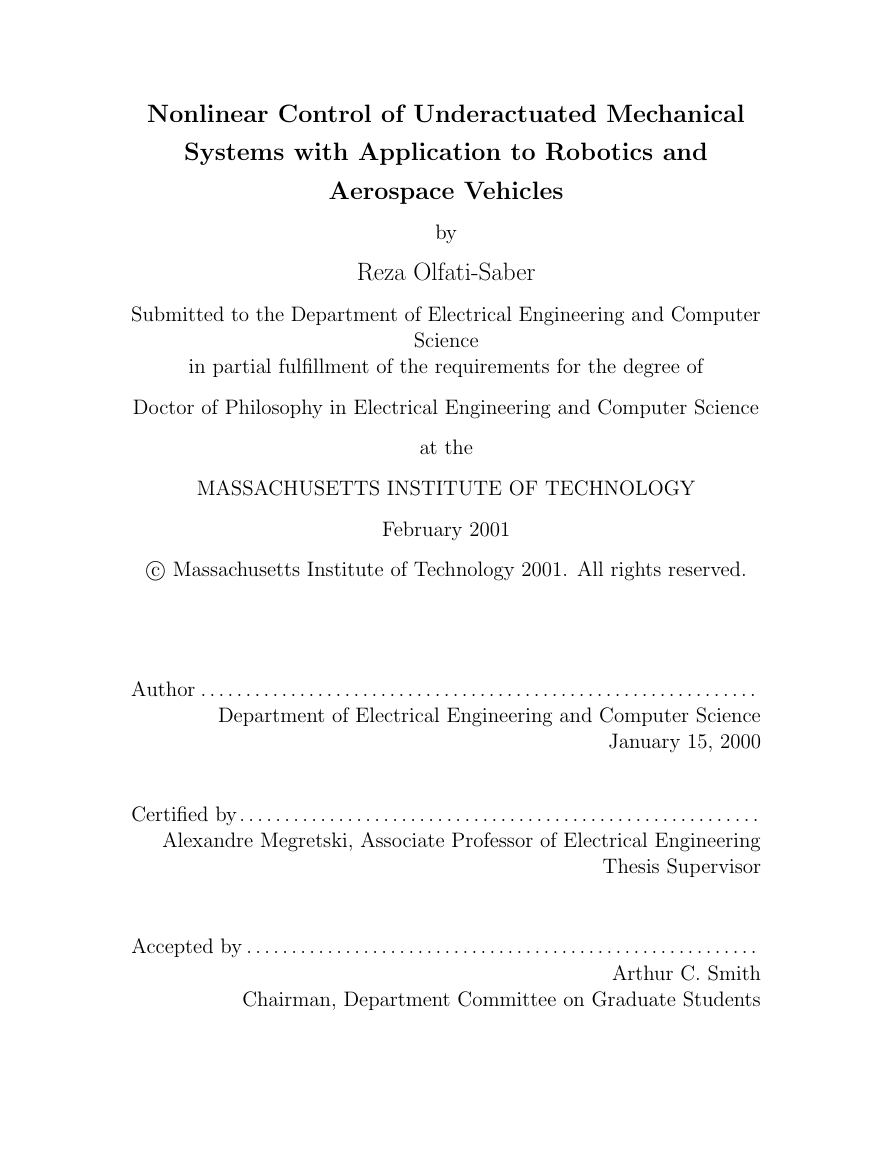

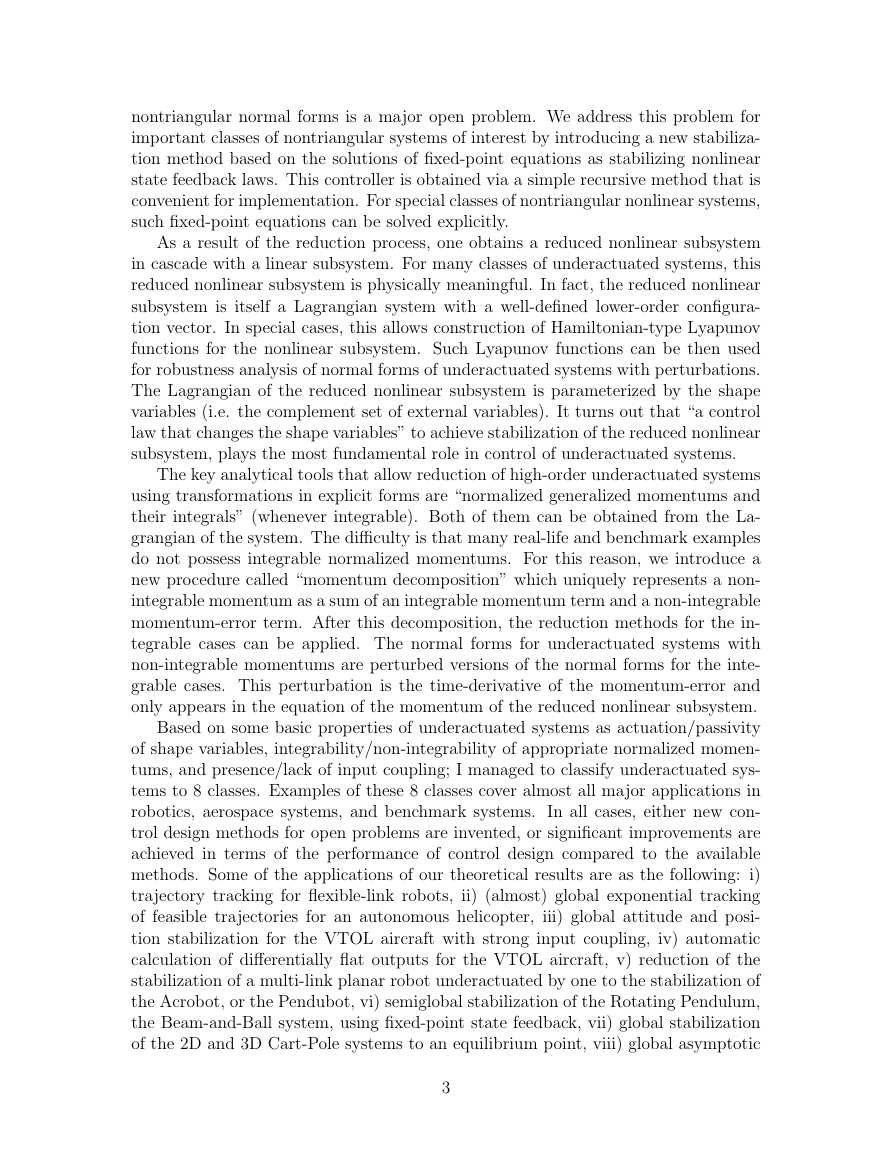
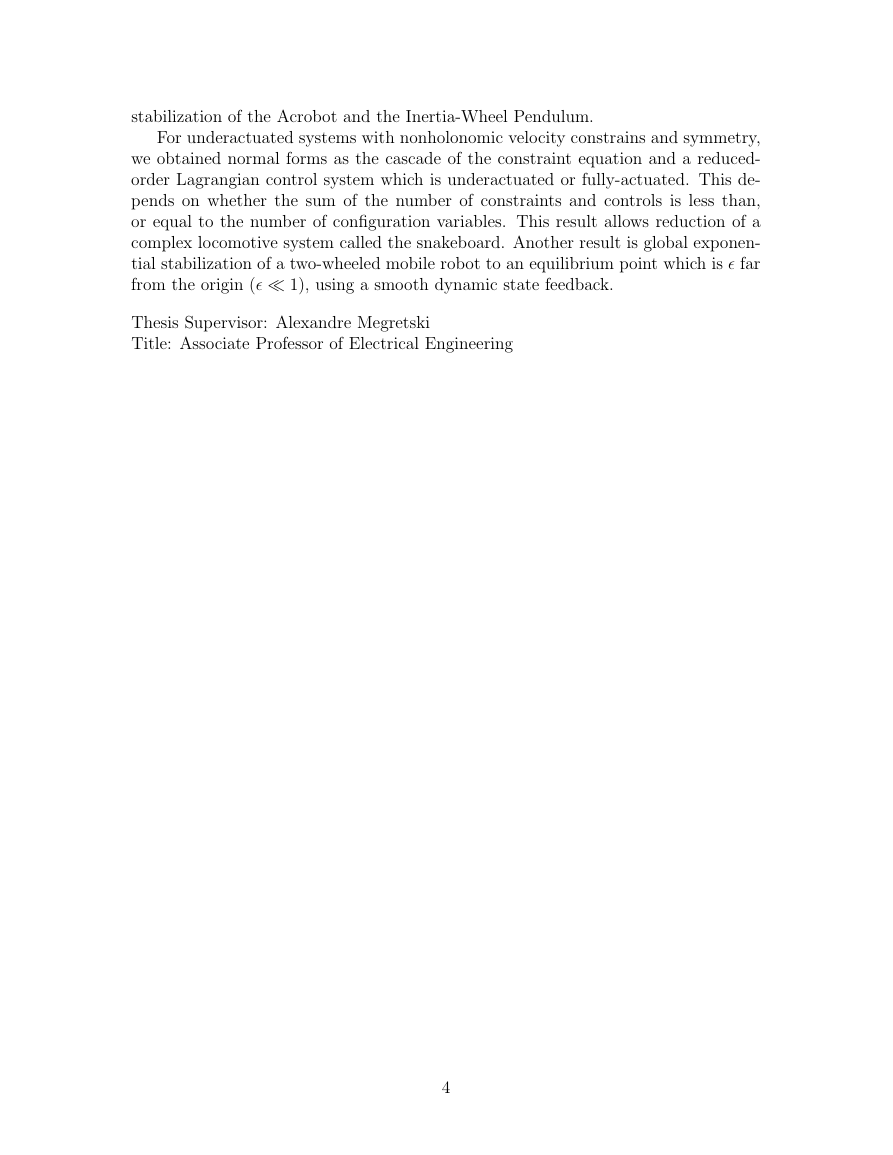
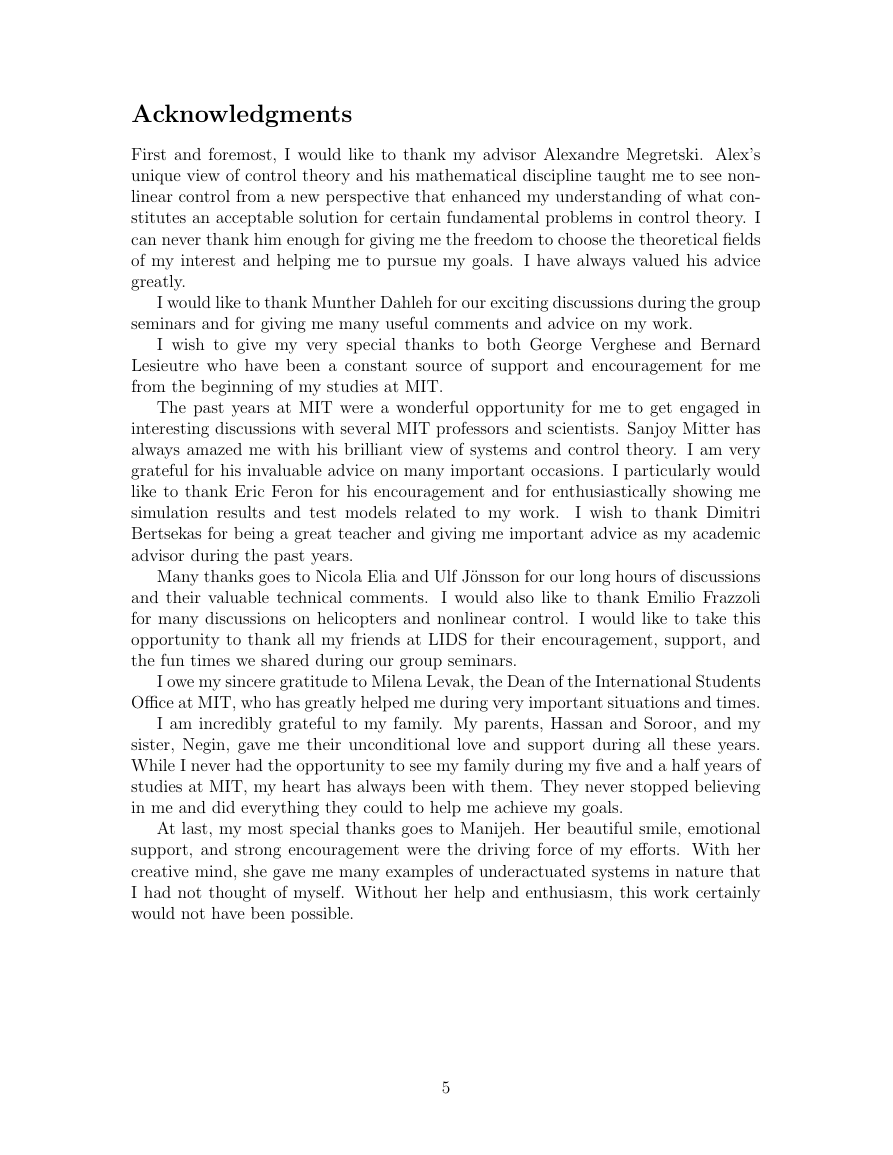
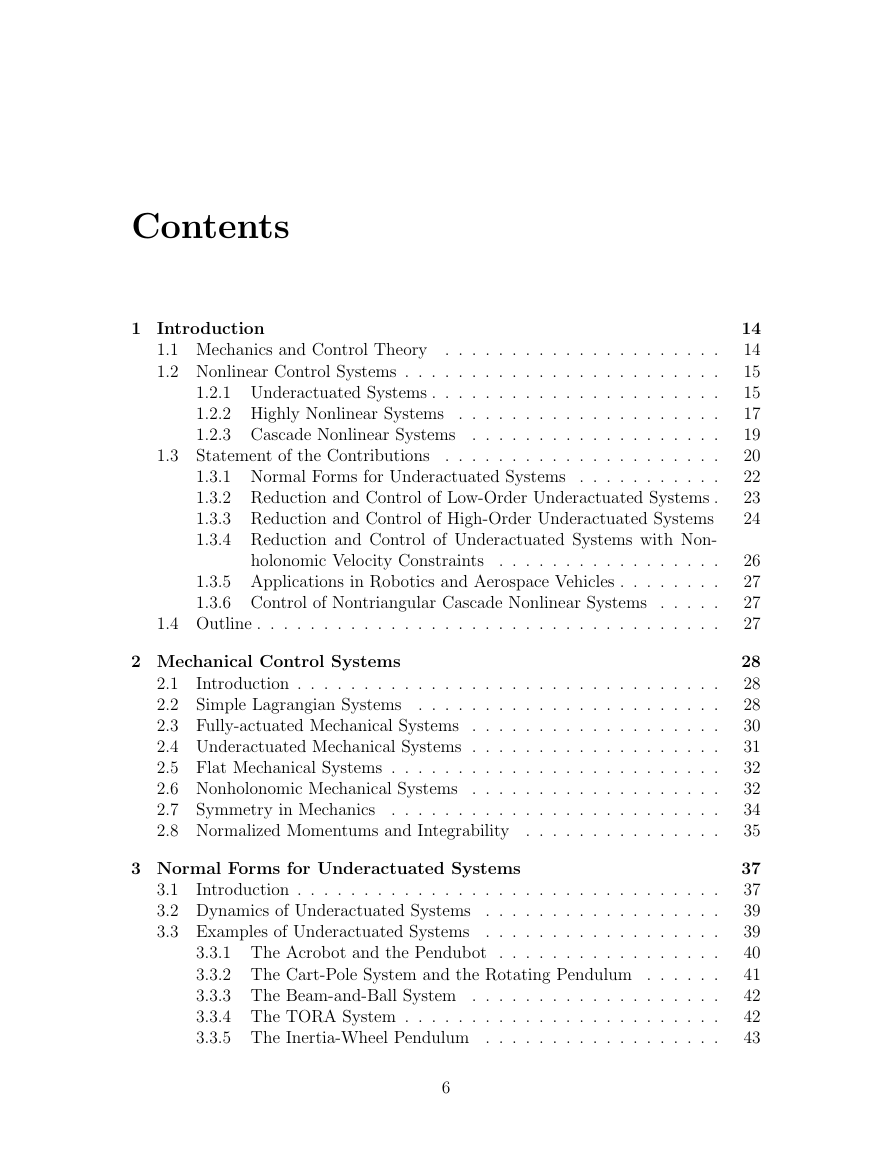
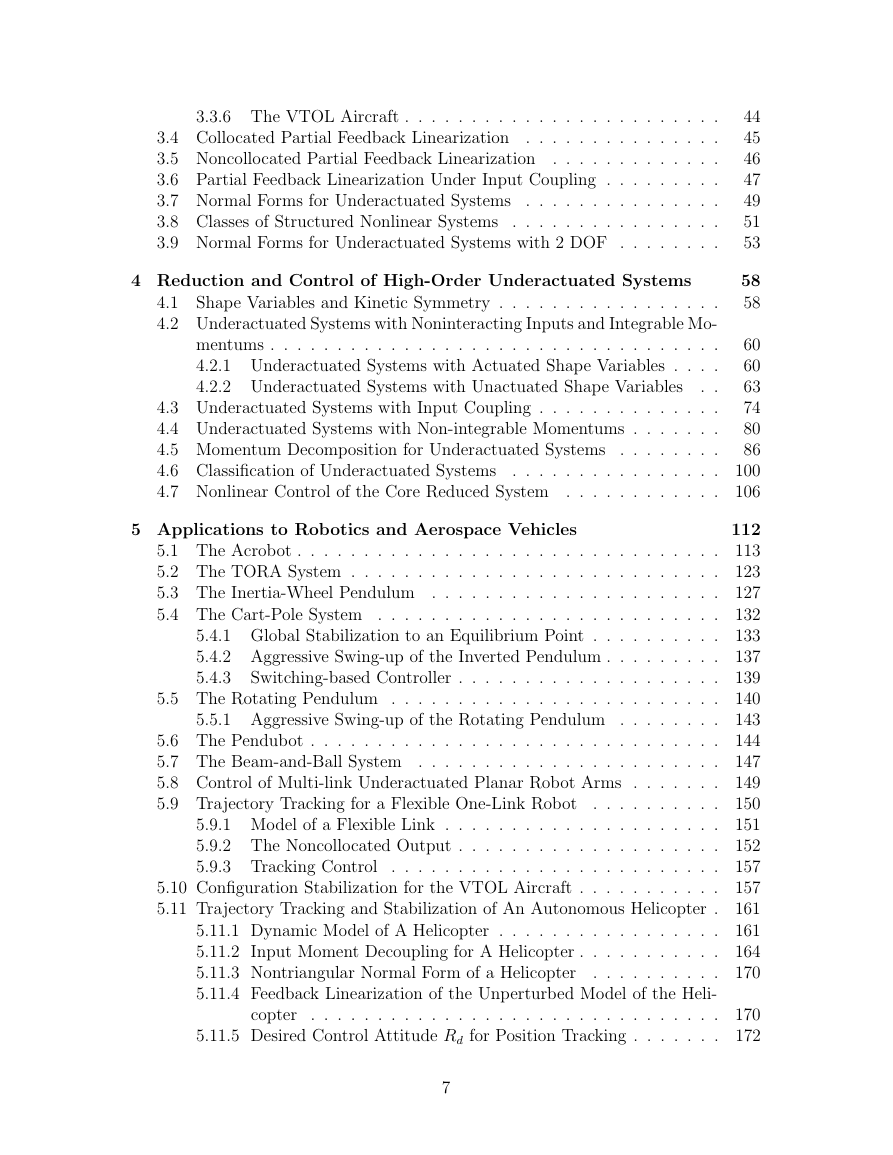
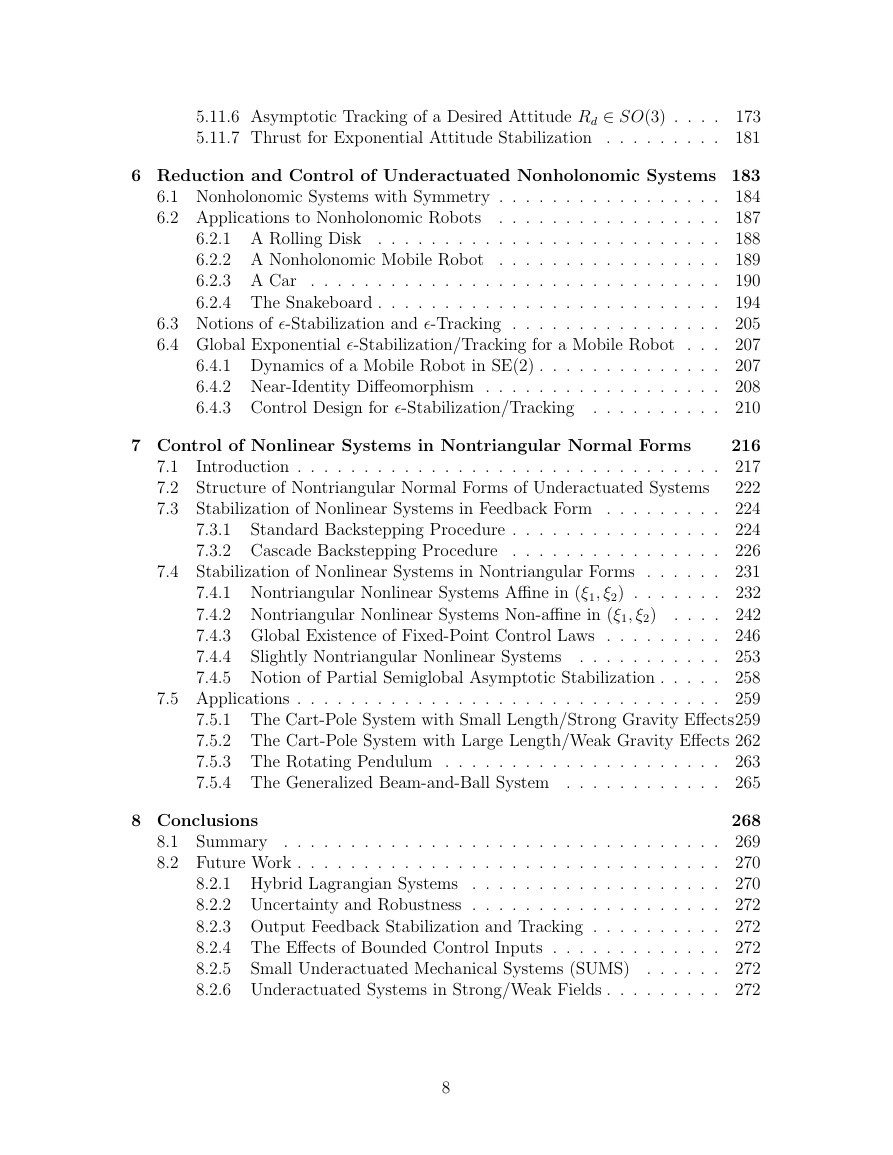








 2023年江西萍乡中考道德与法治真题及答案.doc
2023年江西萍乡中考道德与法治真题及答案.doc 2012年重庆南川中考生物真题及答案.doc
2012年重庆南川中考生物真题及答案.doc 2013年江西师范大学地理学综合及文艺理论基础考研真题.doc
2013年江西师范大学地理学综合及文艺理论基础考研真题.doc 2020年四川甘孜小升初语文真题及答案I卷.doc
2020年四川甘孜小升初语文真题及答案I卷.doc 2020年注册岩土工程师专业基础考试真题及答案.doc
2020年注册岩土工程师专业基础考试真题及答案.doc 2023-2024学年福建省厦门市九年级上学期数学月考试题及答案.doc
2023-2024学年福建省厦门市九年级上学期数学月考试题及答案.doc 2021-2022学年辽宁省沈阳市大东区九年级上学期语文期末试题及答案.doc
2021-2022学年辽宁省沈阳市大东区九年级上学期语文期末试题及答案.doc 2022-2023学年北京东城区初三第一学期物理期末试卷及答案.doc
2022-2023学年北京东城区初三第一学期物理期末试卷及答案.doc 2018上半年江西教师资格初中地理学科知识与教学能力真题及答案.doc
2018上半年江西教师资格初中地理学科知识与教学能力真题及答案.doc 2012年河北国家公务员申论考试真题及答案-省级.doc
2012年河北国家公务员申论考试真题及答案-省级.doc 2020-2021学年江苏省扬州市江都区邵樊片九年级上学期数学第一次质量检测试题及答案.doc
2020-2021学年江苏省扬州市江都区邵樊片九年级上学期数学第一次质量检测试题及答案.doc 2022下半年黑龙江教师资格证中学综合素质真题及答案.doc
2022下半年黑龙江教师资格证中学综合素质真题及答案.doc